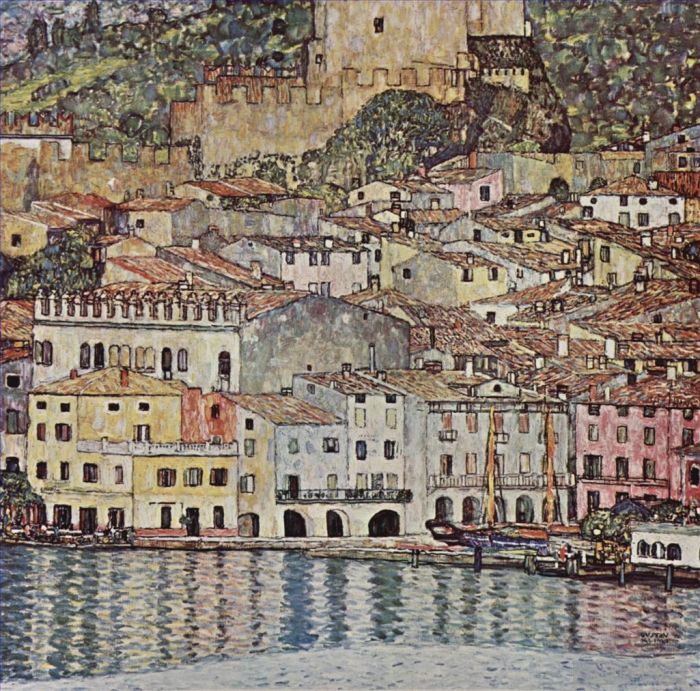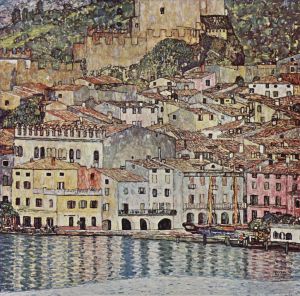Malcesine am Gardasee (Malcesine on Lake Garda)
Gustave Klimt
- Price: Price on Request
- Art Type: Oil Painting
- Size:
- English Comments: 0
- International Comments: 0
- Creating Date:
- Introduction and Works of Gustave Klimt >>
Work Overview
- Malcesine am Gardasee (Malcesine on Lake Garda)
Measures: 110 x 110 cm
Technique: Oil on canvas
Depository: Destroyed by a fire set by retreating German forces in 1945 at Schloss Immendorf, Austria.
This painting originates from the same point of view as the painting 'Kirche in Cassone' from the peninsula of Val di Sogno. After 30 years Klimt once again uses human figures as staffage in a landscape.
Malcesine is a comune (municipality) in the Province of Verona in the Italy|Italian region Veneto, located about 120 km northwest of Venice and about 40 km northwest of Verona. Malcesine lies on the shores of Lake Garda.
Main sights
Its most prominent landmark is the Castello Scaligero, which has 13th-century fortifications and an older medieval tower. Remnants of an Etruscan civilization|Etruscan tomb have been found within the castle walls. The castle was fortified by the della Scala family who ruled the region throughout the 13th century. Other sights include the pieve of St. Stephen (8th century), the church of Santa Maria di Navene (11th century) In 1786, Goethe was questioned by the local magistrate on suspicion of being a spy while drawing sketches of the castle. The German writer recalled the incident in his report about the Italian Journey. Behind Malcesine rises the 2218 meters high Monte Baldo. A cable car with rotating cabins takes passengers to 1750 meters above the sea level. From there the highest point can be accessed by walking few kilometers to the south along the ridge.
In 1913 Klimt broke with his annual three-month visit to Attersee spa in the Austrian Alps, and went to the Italian Lake Garda instead, possibly under the increasing influence of Egon Schiele, who preferred to travel abroad. Whether as a result of the change of light or scenery, this work amply demonstrates its superb effect on him. As in Austria, Klimt paints the scene from a boat out on the water, yet the dramatic distinction of this landscape is the transformed handling of subject-matter, panorama, lighting, and form. It is a wonderful light, expansive work unlike the usual claustrophobic style of his typically intense Austrian scenes. The atmosphere is of life and frivolity rather than the somber, emotionally charged visions of home.
Some critics point to Cubism as the agent of change. Klimt came into contact with the movement during recent trips to Paris where works of Palbo Picasso and Georges Braque were on display. Schiele's own landscapes during this period certainly explore a more Cubist approach and both artists probably discussed the dynamic implications of this new formal esthetic. But in Klimt's case, comparison with Cubism is stretching a point. Here its influence was only experimental and conducted in a casual, limited fashion. Sadly, this singular work was also destroyed in the Schloss Immendorf fire.
- Copyright Statement:
All the reproduction of any forms about this work unauthorized by Singing Palette including images, texts and so on will be deemed to be violating the Copyright Laws.
To cite this webpage, please link back here.
- >> English Comments
- >> Chinese Comments
- >> French Comments
- >> German Comments
- >>Report
- Woman in Gold
- Portrait of Adele Bloch-Bauer I
- Stiller Weiherim Schlobparkvon Kammer
- The Beethoven Frieze 1902
- Water Snakes II(Water Serpents II)
- Malcesine am Gardasee (Malcesine on Lake Garda)
- Portrait of Adele Bloch-Bauer II
- Buchenhain
- Portrat der Fritza Riedler
- Gartenmit Huhnernin StAgatha
- Sonja Knips
- Nuda Veritas
- Avenue of Schloss Kammer Park
- Bauernhausin Oberosterreich
- Bildnis Fritza Riedler 1906
- Judith
- Die Musik
- Minerva or Pallas Athena
- The Kiss
- Houses at Unterach on the Attersee
- Portrait of a Lady
- Die Liebe
- Two Girls With An Oleander
- Fable
- Gold fish
- Farmhouse with Birch Trees
- Design for the Stocletfries
- Church in Unterach on the Attersee (Church in Unterach on Lake Attersee)
- Gartenmit SonnenblumenaufdemLande
- Chruch in Cassone
- Pine Forest II
- University of Vienna Ceiling Paintings
- Mohnfeld
- Fredericke Maria Beer
- Apple Tree II
- Farm Garden with Crucifix
- Portrateiner Dame
- The Virgin (The Maiden)
- Landscape Garden Meadow in Flower
- Dame mit Cape 1897
- Beech Grove I (Beech Forest I)
- The Girl friends (The Lesbians)
- Lady with Fan 2
- Der Beethovenfries Wandgemaldeim Sezessionshausin Wienheuteosterr 2
- Garden with Roosters (Garden Path with Chickens)
- Water Snakes (Watersnakes I or Water Serpents I)
- Danae (Danaë)
- Lady with Fan
- Apple Tree I
- Portrait of Hermine Gallia
- Portrait of a Lady 3
- The Virgins
- The Big Poplar II
- Baby
- The Dancer
- Flower Garden (Farm Garden)
- The Sunflower
- Schlob Kammeram Attersee
- Portratder Friederike Maria Beer
- Love 1895
- Teas in Klimt Style
- Lakeside with Birch Trees
- Reclining Nude Lying on Her Stomach and Facing Right
- Portrait Of Eugenia Primavesi
- Die Grobe Pappeloder Aufziehendes Gewitter
- Portrat der Margaret Stonborough Wittgenstein
- Fir Forest I
- Park of Schönbrunn (Schönbrunn Palace Garden)
- Water Castle
- Death and Life
- Schubert at the piano I
- Farmhouse in Upper Austria
- Baby 3
- Amalie Zuckerkandl
- Portrat der Maria Munk
- Portrait of a Girl
- Emilie Floge Aged 17
- Portratder Baroness Elisabeth BachofenEcht
- Italian horticultural landscape
- Portrait of Gertha Felssovanyi
- Hope I
- Blooming field
- The Beethoven Frieze The Longing for Happiness Finds Repose in Poetry
- The House of Guardaboschi
- Schloss Kammer on the Attersee IV
- Fruit Trees
- Mada Primavesi c 1912
- The Women Friends
- Mother with Children
- Portrait of Serena Lederer
- Roses under the Trees
- Bildnis Margaret Stonborough Wittgenstein 1905
- Bewegte Wasser
- Lady with Hat and Featherboa
- After the Rain Garden with Chickens in St Agatha
- Country House by the Attersee
- The Beethoven Frieze The Hostile Powers Far Wall
- Portrait of Emilie Floge 2
- Portrait of Marie Breunig
- Untitled landscape
- Derschwarze Hut
- The Swamp
- Portrait of Helene Klimt
- Der Beethovenfries Wandgemaldeim Sezessionshausin Wienheuteosterr 4
- Portrait of Emilie Floge
- Portratdes Schauspielers Josef Lewin skyals Carlos
- Baby 2
- Judith and the Head of Holofernes
- Mulhersentada
- The Three Ages of Woman
- Adam and Eva
- Horticultural landscape with a hilltop
- Hope II
- Sapho
- Kuheim Stall
- Portrait of Baroness Elisabeth Bachofen Echt red
- The Tree of Life Stoclet Frieze
- Island in the Attersee
- Farm Houses with Birch Trees
- Schloss Kammer am Attersee II
- Das Hausvon Guardaboschi
- Girl with Long Hair with a sketch for Nude Veritas
- Fishblood
- Allegory of Sculpture
- Idylle 1884
- Januar









 Singing Palette
Singing Palette